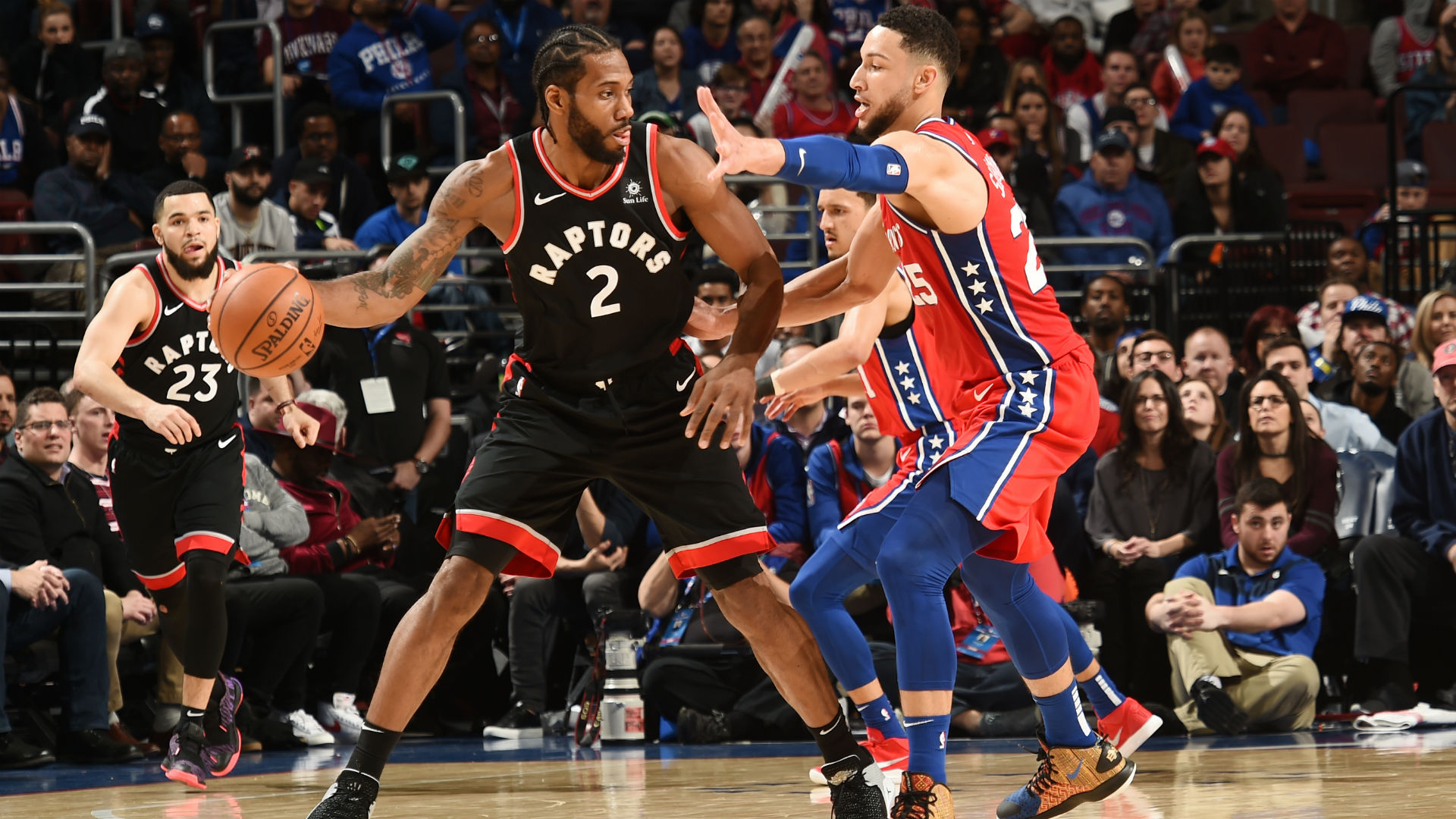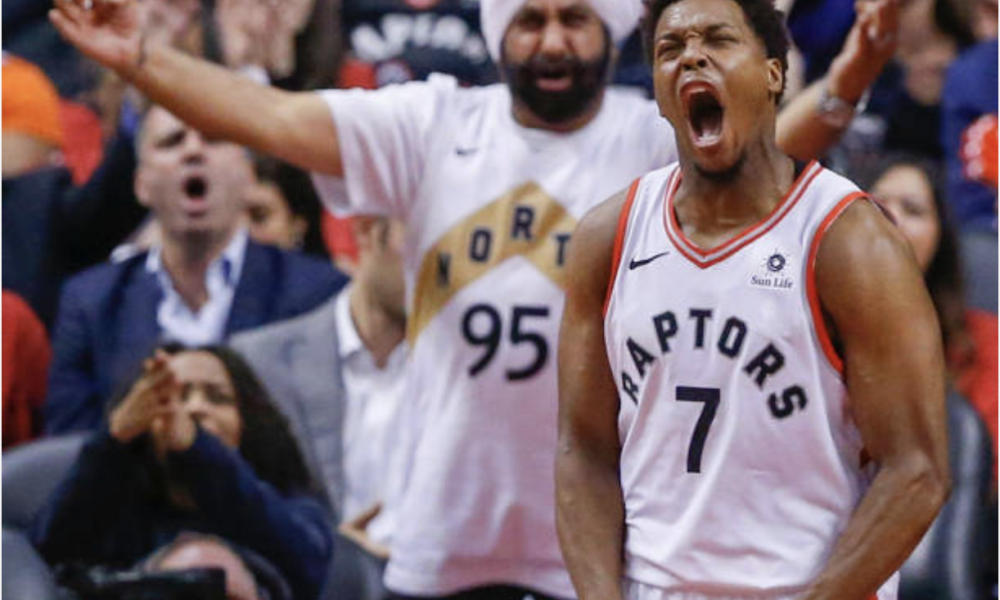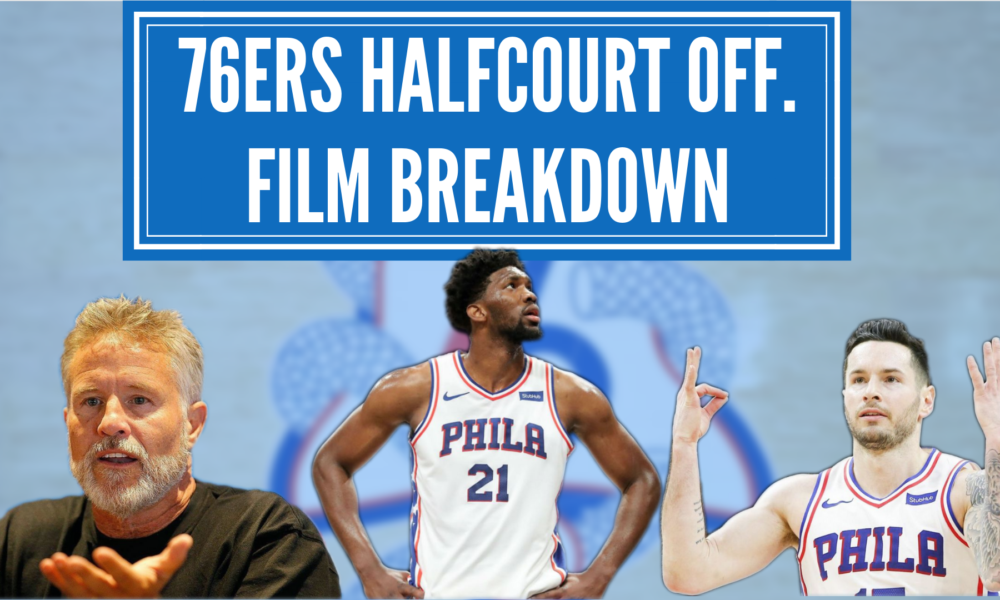For much of the regular season the top four teams in the Eastern Conference had separated themselves from the pack. Once the All-Star break came (and Victor Oladipo had suffered a gruesome injury) it was all but confirmed that their paths would eventually cross. After the Toronto Raptors and Philadelphia 76ers brushed aside their young first round opponents on Tuesday night, the stage has finally been set. The Raptors will host the 76ers on Saturday night while the Milwaukee Bucks and Boston Celtics complete the other side of the bracket.
Now things are going to get tasty.
When reflecting upon the regular season series between the Raptors and 76ers, it is hard not to feel confident. The Raptors won three of the four matchups by double digits and were blown out in their solitary loss with Kyle Lowry hampered by a back issue and Kawhi Leonard managing his load. However, since the their last encounter in February, both teams are markedly different. Philly and Toronto were major players during a frenetic trade deadline in which the Raptors acquired a former Defensive Player of the Year in Marc Gasol, and the 76ers brought in borderline All-Star Tobias Harris from Los Angeles.
Starting out right
So, how have these new pieces changed their respective teams? Pretty damn well, actually.
Via @TheAthleticNBA's @ekoreen: "Over 76 minutes through 4 games, the Raptors' starters have an obscene net rating of +41.4 points per 100 possessions, with an offensive rating of 125.2 and a defensive rating of 83.8. […] It should not be a surprise."https://t.co/yVqf7RYyOi
— J.E. Skeets (@jeskeets) April 22, 2019
Toronto’s new starting lineup with Gasol replacing Serge Ibaka absolutely eviscerated opponents during the regular season by an average of 14.4 points per 100 possessions. That dominance has been taken to new heights in the playoffs; the starting unit were +84 over the first round.
Likewise, the introduction of Harris has given Philadelphia a behemoth of a starting lineup. Each of their starting five averaged at least 16 points per game which is absolutely ridiculous. A small time window and multiple injuries limited their minutes together in the regular season, but they still outscored their opponent by 20.3 points per 100 possessions. That is a scary number. The starters finished +71 in their matchup against Brooklyn. Each team’s starting lineups have become utterly dominant in the playoffs.

(for a deeper dive into the data of the series matchup, make sure to read Louis Zaltman’s extensive preview here.)
The heavy lifting of Philadelphia’s starting unit is also reflective of its incredibly thin bench. They have been going eight deep in the playoffs and are still juggling bench minutes in order to find some semblance of production. The only reliable substitute has been noted Raptor killer, Mike Scott. Boban Marjanovic only receives a smattering of minutes if he remains passable on the defensive end of the floor. The other rotational players are a potpourri of mediocrity.
Throughout the regular season the Raptors bench was also a picture of inconsistency. The talent was there, but the results were not. The trio of Raptors backups in the playoff rotation – Ibaka, Fred VanVleet, and Norman Powell – stayed afloat in their minutes against Orlando, before excelling in games four and five. Although Toronto has the depth advantage, this series will be determined by the starting units. I know that this is an ice-cold take, but the level that Philadelphia leans upon their starters and the obscene production of each team’s opening five amplifies this truism even further.
This is why the individual matchups that begin from the opening tip will be so interesting.
Leonard vs. Simmons
October 30th, 2018 was the day that I fell for Kawhi Leonard. That date marked the first matchup between Philadelphia and Toronto; it also marked the first time that Leonard displayed his devastating defensive abilities to this city:
All four of Leonard’s steals were on Ben Simmons. It was like taking candy from a 6’10” baby. Anytime Simmons dribbled the ball for a half-second too long or delivered a loose pass, Leonard and his infinite limbs were there. The Philadelphia point guard finished the night with 11 turnovers total.
Nick Nurse should look to employ Leonard on Simmons at all times. In the three games that Leonard has played this has clearly been their strategy – Leonard has defended Simmons in 115 possessions, the most possessions he has spent on any player. In those possessions Simmons has only scored 17 points, delivered 10 assists, and turned the ball over nine times. Sheesh. Leonard has not committed a single foul on Simmons and has drawn three offensve fouls. Double sheesh. Simmons has a -8.4 individual point difference when guarded by Leonard. Point difference is measured by a player’s points per 100 possessions in a specific matchup compared to his season average points per 100 possessions, per NBA.com. In fact, not one player in the league has a positive points differential when guarded by Leonard (minimum 60 possessions).
And look where Leonard picks up Simmons above the break:
That is what makes this defensive assignment even more perfect for Toronto. Simmons is a minimal threat off of the ball. The Raptors, like much of the league, have completely ignored Simmons when he does not have the ball in his hands. This allows Leonard to assume that free safety role in which he roams across the court destroying the offence’s attempted sets by filling passing lanes. If Philadelphia sit Simmons in the dunker position then Leonard can immediately harass Joel Embiid from the weakside any time he drives or dishes and gets to be a general nuisance around the basket.
The Raptors are such a strong defensive unit that leaving Simmons in that dunker position is essentially conceding a 4 vs. 5 offensive possession. That severely limits the space for their best player, Joel Embiid, to operate. Brett Brown will have to be creative in how he inserts Simmons into the offence in order to avoid clogging a starting line that doesn’t overflow with shooting talent.
One of the several headline grabbing moments of the first round was Simmons’ rivalry with Jared Dudley, one of the weirdest feuds this side of Lebron James vs. DeShawn Stevenson. Dudley famously noted in a press conference that ¨Ben Simmons is a great player in transition… and once you get him into half court, he’s average.”
Now this is certainly an overstatement – Simmons is an already an All-Star in his second season – but the point still remains. Simmons is at his best in the full court; 19.7 per cent of his points came in fast break situations which is the fourth most for point guards, behind Russell Westbrook, Eric Bledsoe, and De’Aaron Fox. Simmons is the fuel that has driven the 76ers to the eighth fastest pace in the league.
At the same time, the 76ers offence can be reckless. They sit 24th in the league in turnover rate, Simmons averaged 6.3 turnovers per game against the Raptors, and the team as a whole coughed the ball up 18.8 times per game against Toronto this season. For reference, the Atlanta Hawks averaged the most turnovers throughout the season at 17.0 turnovers per game. Meanwhile, the Raptors are killers in the full court. They averaged 1.19 points per possession in fast break situations, which is first in the league, and have a racehorse in Pascal Siakam who thrives in transition.
The Raptors dominate in the world where Simmons is most comfortable.
Now I don’t think wind sprints up and down the court is necessarily the recipe for the Raptors to win this series as they execute far better in the half court on both ends of the floor, however it is comforting to know that they can go stride for stride when the game does open up. A better way for the Raptors to keep the pace up without allowing the game to descend into chaos is to execute in semi-transition. They were deadly with quick hitters against the Magic when the defence was scrambled:
Gasol vs. Embiid
I need to preface this segment by acknowledging my Gasol bias. Embiid is a singular talent, one of my favourite players to watch, and is objectively a better basketball player than Gasol at this stage of their careers. But there is no denying that Big Spain has been the best defender on Embiid in the entire league.
The big men have had two regular season encounters this season, both while Gasol was still in Memphis. During the 108 possessions that Gasol guarded Embiid he only managed 17 points, five assists, and had seven turnovers. Embiid shot 33 per cent from the floor and posted -22.5 individual points difference in those possessions, by far his worst against any player in the league (minimum 60 possessions).
Two games and 108 possessions is a small sample size. However, the season prior paints a similar picture: in the 70 possessions Gasol defended Embiid he scored 12 points and had a 36.4 field goal percentage. Embiid once again had his lowest individual points difference, -19.7, in this matchup. Gasol’s defensive numbers on Embiid are a statistical outlier; no one else comes close to limiting the dominant Cameroonian.
I am not coining Gasol ‘The Embiid Stopper’. Raptors fans know that inserting the title ‘Stopper’ after a player’s name is the ultimate kiss of death. Embiid averaged 24.8 points, 13.5 rebounds, 2.8 blocks on a hobbled knee against the Nets, is a top five MVP candidate, and will no doubt have games where he dominates inside this series. But Gasol will make his life incredibly difficult. The above clip is reminiscent of Gasol’s defence on Nikola Vucevic in which he erased the centre entirely. Despite the newly slimmed body courtesy of his homemade veggie patch, Gasol still bangs down low and does not concede deep post position. He constantly ushered Vucevic to the peripheries of the court and cut off the centre from going into his usual bag of tricks. Gasol’s brute physicality combined with nimble footwork and defensive instincts has been at the heart of his success for 11 seasons.
This won’t be a strictly one-on-one matchup. Gasol will have weapons flanking him from either side. Help defence will rifle towards Embiid in the post from all angles as wing defenders will no doubt venture away from Simmons and occasionally Jimmy Butler. Embiid averaged 0.9 turnovers per game in post-ups, the second highest mark in the league, but has also improved his playmaking abilities. In the Brooklyn series Embiid carved attempted double-teams with knifing passes, dishing seven assists out of the post and committing zero turnovers.
Gasol will be far better than Jarrett Allen at dislodging Embiid from the low block. The likes of Siakam and Leonard lurking is also going to present are far tougher picture for playmaking opportunities:
The first round series displayed the speed and ferocity of the Raptors defence when firing on all cylinders. Their aggressive trapping scheme dismantled an Orlando team with limited bail-out options. It was a bold defensive strategy that Nick Nurse veiled during the regular season.
The Raptors were incredible at trapping the pick-and-roll against Orlando, however Philadelphia’s offense is averse to using this action due to Embiid’s comfort on the low block and Simmons’ non-existent jumpshot. They ranked 29th in the league in pick-and-rolls used despite acquiring two stars, Harris and Butler, who thrive in the scenario. This limits Toronto’s defensive aggressiveness, but there is another action that Philadelphia rely upon which is susceptible to being attacked.
Embiid has a deadly two-man game with Redick. The two player’s rotational minutes often mirror one another, sharing the floor on 27.3 minutes per game during the regular season. A staple of their dynamic, and a lynchpin to the team’s offence, is the DHO. Redick used far more hand-off possessions than anyone else in the league at 5.2 per game and shot a 56.4 effective field goal percentage in those actions.
In the second clip LaMarcus Aldridge doesn’t show high enough to trap, nor does he drop quickly enough to cover the paint which discombobulates the defence. If the Raptors are as finely tuned as they were trapping Augustin/Vucevic pick-and-rolls, then Redick will be forced to become a passer and hit Embiid with precision. From there, the 76ers’ Simmons conundrum arises once again as Leonard will roam away and berate Embiid from the weak side once the ball touches his hands. Philadelphia’s ability to read these scenarios and make passes accordingly will dictate the success of their offence.
(Cooper Smither has done a video breakdown on Philadelphia’s half-court offence here.)
On the other side of the ball, Toronto can really test Philadelphia’s defence in the pick-and-roll. At face value it may not seem like the most logical option – Embiid is a monster in the paint, Philly happily funneled pick-and-roll ballhandlers towards the rim against Brooklyn, and Toronto don’t run too much of it in the first place. Opponents only shot 53.3 per cent at the rim against Embiid in the regular season and I’m sure Lowry has many memories of being stifled by the giant down low. Despite this, Philadelphia’s on-ball defenders have been porous at times allowing far too much dribble penetration, only to be bailed out by Embiid. The options Toronto can throw in pick-and-roll scenarios are going to test the limits of his defensive capabilities, especially with an injured knee.
Embiid does not like to veer from the paint nor does he want to be forced into a defensive switch. I wouldn’t either if I was a 7’3″ blocking machine. Embiid dropping with regularity requires the on-ball defender to work hard through the screen. Just look at the separation Lowry and VanVleet get from Redick here:
Phewf. It took Redick longer to get around those Monroe screens than it does for my grandpa to make it up the stairs, bless his soul. Also, shoutout Moose! That amount of separation is devastating because it can force a switch in which Gasol or Ibaka will post up Redick. Both bigs are more than capable of slipping into a pick-and-pop at the elbow as well. It also gives a full runway for the ballhandler to head to the rim. This may not be a wise option against a fully healthy Embiid, but look at how Caris Levert was able to attack inside during game four. That doesn’t look like peak Embiid to me.
https://www.youtube.com/watch?v=qYY_acz3nno
Philadelphia were seventh best in the league defending the roller in pick-and-roll situations but only 19th in defending the ballhandler, measured by points per possession. On-ball defenders were often lazy and relying on Embiid’s presence to deter oncoming traffic. Now Philadelphia must account for the bone crunching screens that Gasol sets and also a dude by the name of Kawhi Leonard. I haven’t mentioned him in a few paragraphs, so I’m obliged to remind everyone that he’s the best player in the series. Leonard is also one of the best mid-range shooters off the dribble and if he is offered that kind of space then it is an easy two points. Against Orlando, Leonard average a strong 0.97 points per possession on 6.2 possessions per game as the ballhandler in those scenarios. Fans on both sides will hold their collective breaths the moment he decides to try and take Embiid on at the rim.
There will of course be adjustments and subsequent counter adjustments (shouts Nick Nurse for actually being an adaptable coach). But these individual matchups and in-game scenarios will dictate how the opening games of the series will unfold.



